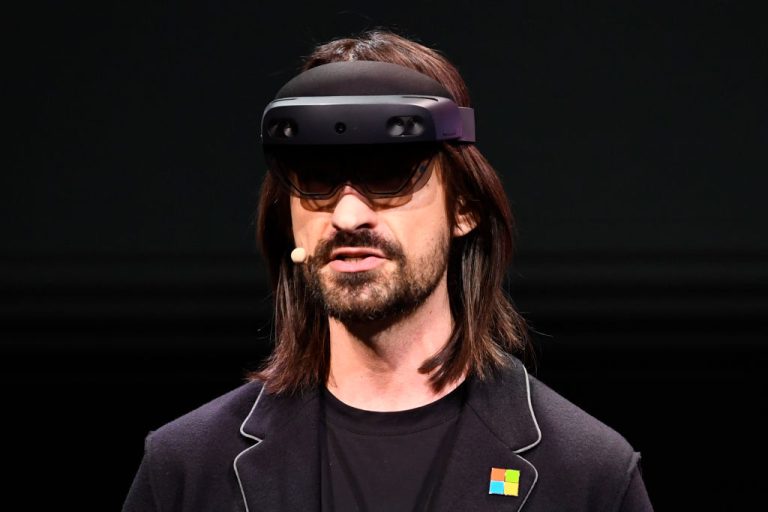Cutting edge technology is rarely all it’s cracked up to be, military testers found after a spectacularly failed trial of the fruits of a $22 billion contract awarded to Microsoft to deploy its HoloLens augmented reality glasses to U.S. troops.
Damningly, the greatest concern seems to have been the most obvious of design blunders: the glasses emit so much light that it’s “visible from hundreds of meters away,” Business Insider stated in an Oct. 11 report.
The comments came from an internal army report “dictated to Insider” in addition to “a Microsoft employee briefed about the event.”
MORE ON THE MIRAGE OF VIRTUAL AND AUGMENTED REALITY
- Japanese Startup Builds Electroshock Bracelet to Inflict Pain On Metaverse Users
- You’ll Raise Virtual Children in the Metaverse and Pay for the Privilege: AI Expert
- Facebook Reality Labs AR Glasses Seek ‘Paradigm Shift’ in how Humans Interact With Computers
- Implantable Microchips Are Here to Stay Whether You ‘Like It or Not’
Additional fatal flaws also abounded.
“Testers also found that the soldiers’ field of view including peripheral vision is limited while the headset is on, and the bulk and weight of the device restricts a soldier’s movement,” the article stated.
Success
You are now signed up for our newsletter
Success
Check your email to complete sign up
One tester was directly quoted in the dictated report as stating, “The devices would have gotten us killed,” if used in real combat.
And although according to the Microsoft leaker the HoloLens failed four of six evaluation events, an Army spokesperson who Business Insider spoke with was paraphrased as stating, “The operational test was so far generally considered a success and that the Army remains committed to the IVAS [Integrated Visual Augmentation System] program.”
Commitment from Microsoft to the project was called into question as early as February of this year.
The same publication ran an article citing “someone who was present” at an all hands meeting captained by Chris Capossela, Microsoft’s Chief Marketing Officer, who paraphrased the CMO as stating, “The HoloLens was a nice gadget for promotional videos…but a mere ‘rounding error’ to Microsoft’s business.”
The article also stated that the very same Pentagon contract was already “behind schedule, plagued by quality and performance problems” despite it being the foundation of the project’s image.
A spokesperson for Microsoft told Business Insider at the time that HoloLens was a “critical part of our plans for emerging categories like mixed reality and the metaverse.”
The paper interviewed as many as 20 team members of the project internally, summarizing their responses as “confusion and strategic uncertainty as different factions argue about its future.”
And Microsoft’s team has known the project is pie-in-the-sky for nearly as long.
In March, Business Insider received copies of internal team emails that stated, “We (Microsoft) are going into the event expecting negative feedback from the customer,” in advance of a fifth “soldier touchpoint” trial run for the gadget.
“We expect soldier sentiment to continue to be negative as reliability improvements have been minimal from previous events,” the email added.
More embarrassingly, the email also said that the 34 units delivered for the touchpoint were “unpackaged and have been used by Microsoft employees.”
Further details in the article give the impression that the concept itself may not be viable for combat whatsoever, “The military device itself is internally called ‘Atlas’ and works with a computer strapped to the front of the user and a battery on back.”
The detail is key, as Microsoft, which had previously lauded the HoloLens 3 as an up and coming innovative toy for retail consumers as far back as 2019, scrapped the project in 2021.
Additional February reporting by Business Insider stated that the existing HoloLens 2 “overlays digital images on a user’s view of the real world,” is itself “a self-contained computer operating on Windows,” that “costs upwards of $3,500” and targets “business users.”
The outlet explained that Microsoft instead thought it wise to shift gears to a collaboration with Samsung called “Project Bondi,” described as “intended essentially as a set of screens in a headset with a Samsung phone in your pocket operating as a computer.”
VR is often high on promise and low on delivery.
In June, a newly published and first-of-its-kind study put 18 people inside virtual reality for a full 40 hour work week with an Oculus headset to find whether the highly promoted ambition to have people work their regular jobs inside the Metaverse was viable.
It wasn’t.
The researchers were from Universities in Germany, Slovenia, the University of Cambridge, and notably, Microsoft Research, and found that across the board their test subjects found reduced productivity and focus in addition to significant forms of lasting discomfort, such as headache, neck, and eye strain.







